headrest SKODA FABIA 2014 3.G / NJ Owner's Manual
[x] Cancel search | Manufacturer: SKODA, Model Year: 2014, Model line: FABIA, Model: SKODA FABIA 2014 3.G / NJPages: 216, PDF Size: 30.7 MB
Page 5 of 216
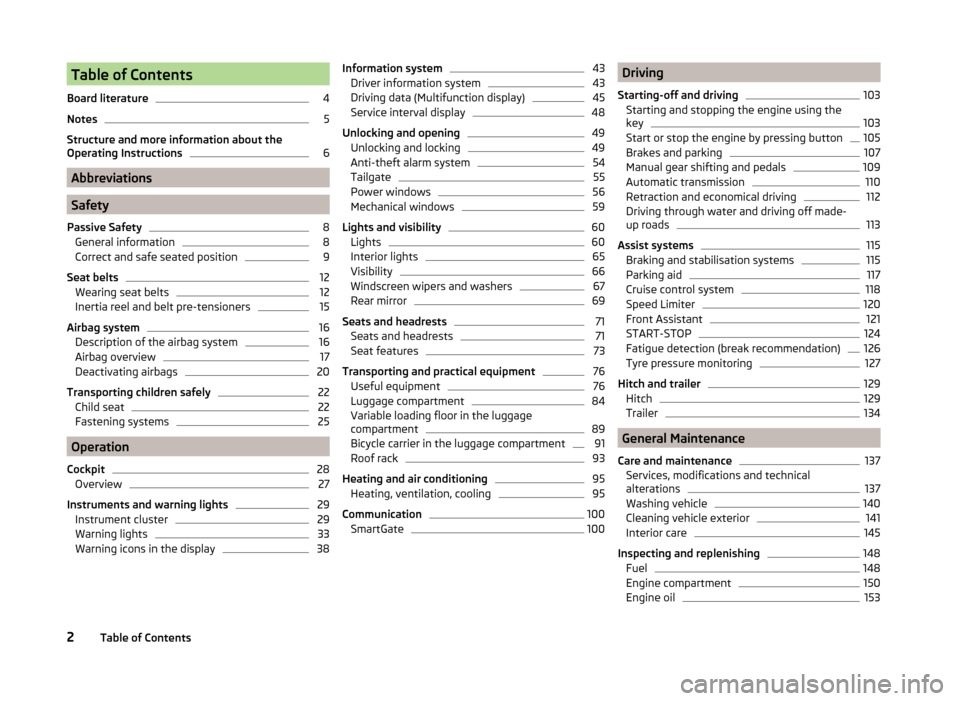
Table of Contents
Board literature4
Notes
5
Structure and more information about the
Operating Instructions
6
Abbreviations
Safety
Passive Safety
8
General information
8
Correct and safe seated position
9
Seat belts
12
Wearing seat belts
12
Inertia reel and belt pre-tensioners
15
Airbag system
16
Description of the airbag system
16
Airbag overview
17
Deactivating airbags
20
Transporting children safely
22
Child seat
22
Fastening systems
25
Operation
Cockpit
28
Overview
27
Instruments and warning lights
29
Instrument cluster
29
Warning lights
33
Warning icons in the display
38Information system43Driver information system43
Driving data (Multifunction display)
45
Service interval display
48
Unlocking and opening
49
Unlocking and locking
49
Anti-theft alarm system
54
Tailgate
55
Power windows
56
Mechanical windows
59
Lights and visibility
60
Lights
60
Interior lights
65
Visibility
66
Windscreen wipers and washers
67
Rear mirror
69
Seats and headrests
71
Seats and headrests
71
Seat features
73
Transporting and practical equipment
76
Useful equipment
76
Luggage compartment
84
Variable loading floor in the luggage
compartment
89
Bicycle carrier in the luggage compartment
91
Roof rack
93
Heating and air conditioning
95
Heating, ventilation, cooling
95
Communication
100
SmartGate
100Driving
Starting-off and driving103
Starting and stopping the engine using the
key
103
Start or stop the engine by pressing button
105
Brakes and parking
107
Manual gear shifting and pedals
109
Automatic transmission
110
Retraction and economical driving
112
Driving through water and driving off made-
up roads
113
Assist systems
115
Braking and stabilisation systems
115
Parking aid
117
Cruise control system
118
Speed Limiter
120
Front Assistant
121
START-STOP
124
Fatigue detection (break recommendation)
126
Tyre pressure monitoring
127
Hitch and trailer
129
Hitch
129
Trailer
134
General Maintenance
Care and maintenance
137
Services, modifications and technical
alterations
137
Washing vehicle
140
Cleaning vehicle exterior
141
Interior care
145
Inspecting and replenishing
148
Fuel
148
Engine compartment
150
Engine oil
1532Table of Contents
Page 26 of 216
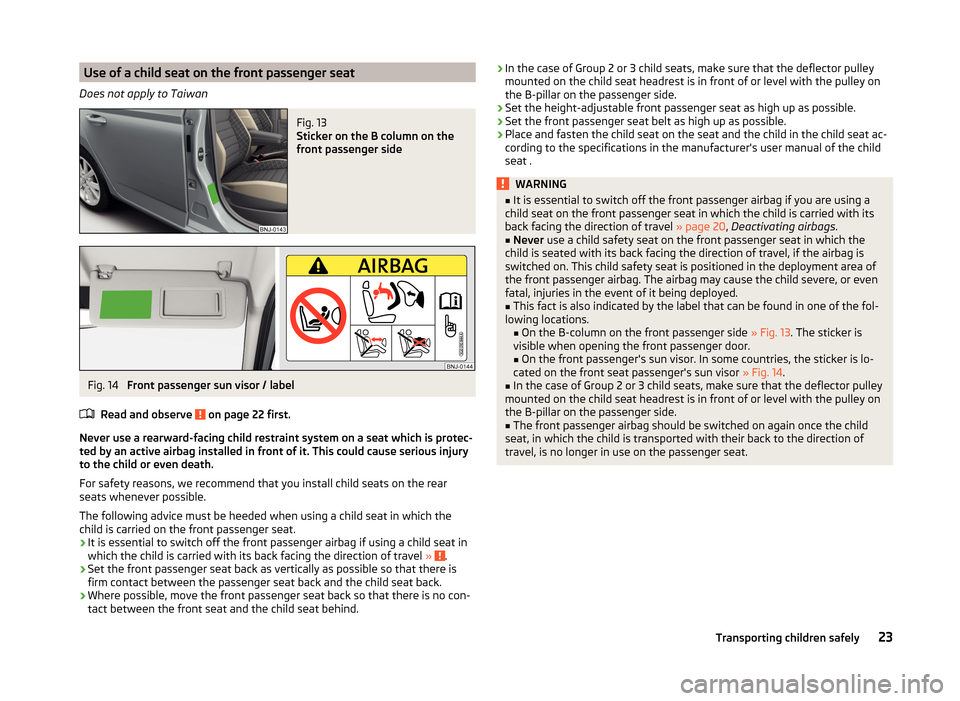
Use of a child seat on the front passenger seat
Does not apply to TaiwanFig. 13
Sticker on the B column on the
front passenger side
Fig. 14
Front passenger sun visor / label
Read and observe
on page 22 first.
Never use a rearward-facing child restraint system on a seat which is protec-
ted by an active airbag installed in front of it. This could cause serious injury
to the child or even death.
For safety reasons, we recommend that you install child seats on the rear
seats whenever possible.
The following advice must be heeded when using a child seat in which the
child is carried on the front passenger seat.
› It is essential to switch off the front passenger airbag if using a child seat in
which the child is carried with its back facing the direction of travel »
.
› Set the front passenger seat back as vertically as possible so that there is
firm contact between the passenger seat back and the child seat back.
› Where possible, move the front passenger seat back so that there is no con-
tact between the front seat and the child seat behind.
› In the case of Group 2 or 3 child seats, make sure that the deflector pulley
mounted on the child seat headrest is in front of or level with the pulley on
the B-pillar on the passenger side.
› Set the height-adjustable front passenger seat as high up as possible.
› Set the front passenger seat belt as high up as possible.
› Place and fasten the child seat on the seat and the child in the child seat ac-
cording to the specifications in the manufacturer's user manual of the child
seat .WARNING■ It is essential to switch off the front passenger airbag if you are using a
child seat on the front passenger seat in which the child is carried with its
back facing the direction of travel » page 20, Deactivating airbags .■
Never use a child safety seat on the front passenger seat in which the
child is seated with its back facing the direction of travel, if the airbag is
switched on. This child safety seat is positioned in the deployment area of
the front passenger airbag. The airbag may cause the child severe, or even
fatal, injuries in the event of it being deployed.
■
This fact is also indicated by the label that can be found in one of the fol-
lowing locations. ■ On the B-column on the front passenger side » Fig. 13. The sticker is
visible when opening the front passenger door.
■ On the front passenger's sun visor. In some countries, the sticker is lo-
cated on the front seat passenger's sun visor » Fig. 14.
■
In the case of Group 2 or 3 child seats, make sure that the deflector pulley
mounted on the child seat headrest is in front of or level with the pulley on
the B-pillar on the passenger side.
■
The front passenger airbag should be switched on again once the child
seat, in which the child is transported with their back to the direction of
travel, is no longer in use on the passenger seat.
23Transporting children safely
Page 28 of 216
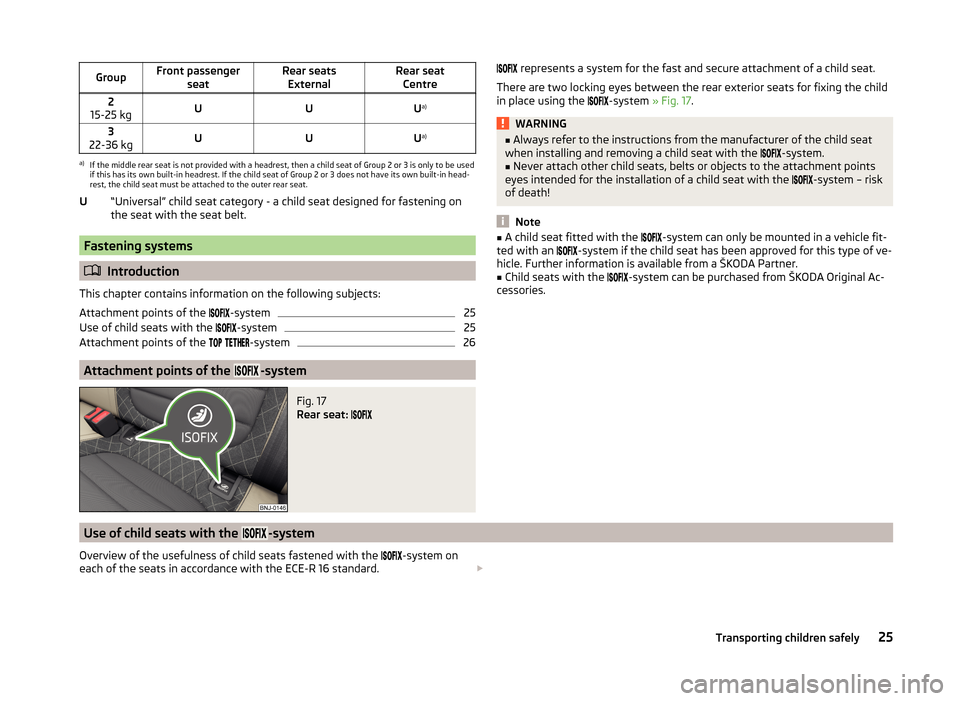
GroupFront passengerseatRear seatsExternalRear seat Centre2
15-25 kgUUU a)3
22-36 kgUUU a)a)
If the middle rear seat is not provided with a headrest, then a child seat of Group 2 or 3 is only to be used
if this has its own built-in headrest. If the child seat of Group 2 or 3 does not have its own built-in head-
rest, the child seat must be attached to the outer rear seat.
“Universal” child seat category - a child seat designed for fastening on
the seat with the seat belt.
Fastening systems
Introduction
This chapter contains information on the following subjects:
Attachment points of the -system
25
Use of child seats with the
-system
25
Attachment points of the
-system
26
Attachment points of the -system
Fig. 17
Rear seat:
U
represents a system for the fast and secure attachment of a child seat.
There are two locking eyes between the rear exterior seats for fixing the child
in place using the
-system » Fig. 17.WARNING■
Always refer to the instructions from the manufacturer of the child seat
when installing and removing a child seat with the -system.■
Never attach other child seats, belts or objects to the attachment points
eyes intended for the installation of a child seat with the
-system – risk
of death!
Note
■ A child seat fitted with the -system can only be mounted in a vehicle fit-
ted with an -system if the child seat has been approved for this type of ve-
hicle. Further information is available from a ŠKODA Partner.■
Child seats with the
-system can be purchased from ŠKODA Original Ac-
cessories.
Use of child seats with the -system
Overview of the usefulness of child seats fastened with the -system on
each of the seats in accordance with the ECE-R 16 standard. 25Transporting children safely
Page 74 of 216
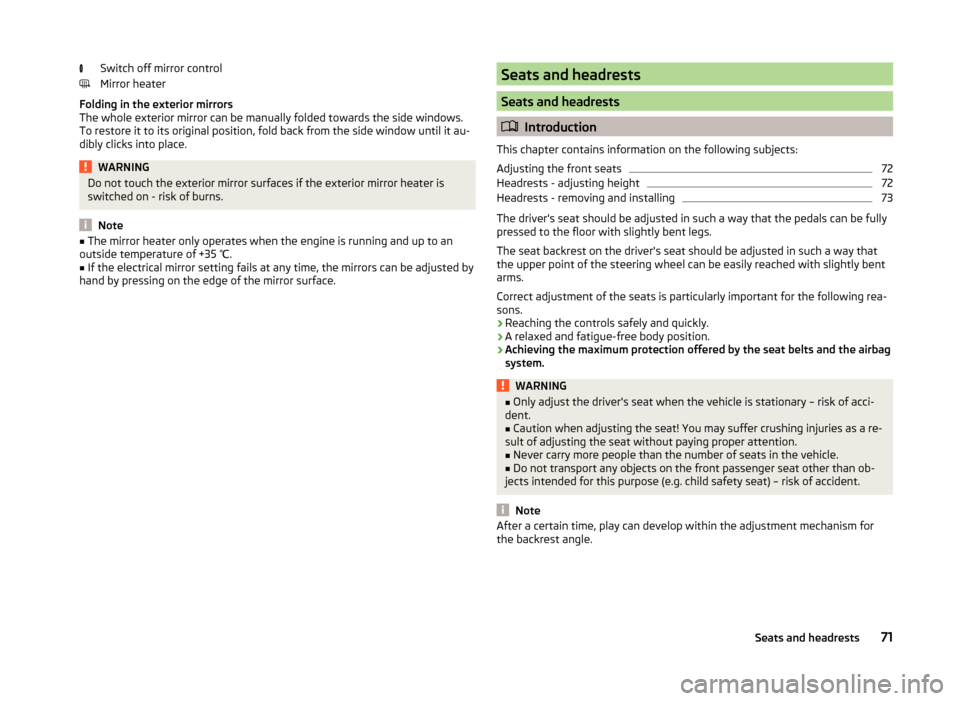
Switch off mirror control
Mirror heater
Folding in the exterior mirrors
The whole exterior mirror can be manually folded towards the side windows.
To restore it to its original position, fold back from the side window until it au-
dibly clicks into place.WARNINGDo not touch the exterior mirror surfaces if the exterior mirror heater is
switched on - risk of burns.
Note
■ The mirror heater only operates when the engine is running and up to an
outside temperature of +35 ℃.■
If the electrical mirror setting fails at any time, the mirrors can be adjusted by
hand by pressing on the edge of the mirror surface.
Seats and headrests
Seats and headrests
Introduction
This chapter contains information on the following subjects:
Adjusting the front seats
72
Headrests - adjusting height
72
Headrests - removing and installing
73
The driver's seat should be adjusted in such a way that the pedals can be fully
pressed to the floor with slightly bent legs.
The seat backrest on the driver's seat should be adjusted in such a way that the upper point of the steering wheel can be easily reached with slightly bent
arms.
Correct adjustment of the seats is particularly important for the following rea-
sons.
› Reaching the controls safely and quickly.
› A relaxed and fatigue-free body position.
› Achieving the maximum protection offered by the seat belts and the airbag
system.
WARNING■ Only adjust the driver's seat when the vehicle is stationary – risk of acci-
dent.■
Caution when adjusting the seat! You may suffer crushing injuries as a re-
sult of adjusting the seat without paying proper attention.
■
Never carry more people than the number of seats in the vehicle.
■
Do not transport any objects on the front passenger seat other than ob-
jects intended for this purpose (e.g. child safety seat) – risk of accident.
Note
After a certain time, play can develop within the adjustment mechanism for
the backrest angle.71Seats and headrests
Page 75 of 216
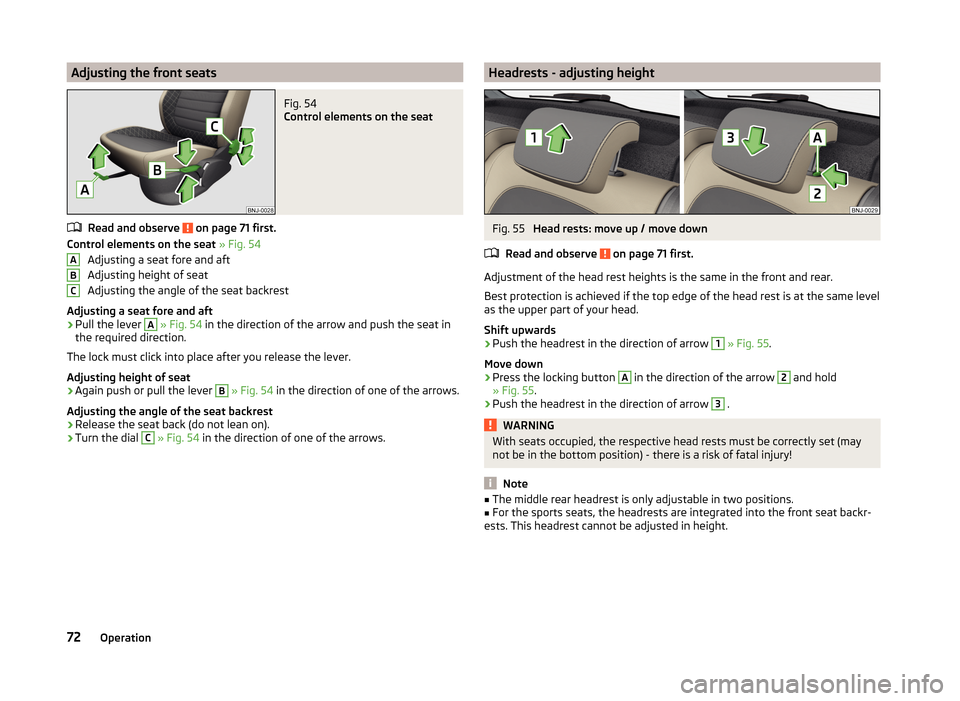
Adjusting the front seatsFig. 54
Control elements on the seat
Read and observe on page 71 first.
Control elements on the seat » Fig. 54
Adjusting a seat fore and aft
Adjusting height of seat
Adjusting the angle of the seat backrest
Adjusting a seat fore and aft
›
Pull the lever
A
» Fig. 54 in the direction of the arrow and push the seat in
the required direction.
The lock must click into place after you release the lever.
Adjusting height of seat
›
Again push or pull the lever
B
» Fig. 54 in the direction of one of the arrows.
Adjusting the angle of the seat backrest
›
Release the seat back (do not lean on).
›
Turn the dial
C
» Fig. 54 in the direction of one of the arrows.
ABCHeadrests - adjusting heightFig. 55
Head rests: move up / move down
Read and observe
on page 71 first.
Adjustment of the head rest heights is the same in the front and rear.
Best protection is achieved if the top edge of the head rest is at the same level
as the upper part of your head.
Shift upwards
›
Push the headrest in the direction of arrow
1
» Fig. 55 .
Move down
›
Press the locking button
A
in the direction of the arrow
2
and hold
» Fig. 55 .
›
Push the headrest in the direction of arrow
3
.
WARNINGWith seats occupied, the respective head rests must be correctly set (may
not be in the bottom position) - there is a risk of fatal injury!
Note
■ The middle rear headrest is only adjustable in two positions.■For the sports seats, the headrests are integrated into the front seat backr-
ests. This headrest cannot be adjusted in height.72Operation
Page 76 of 216
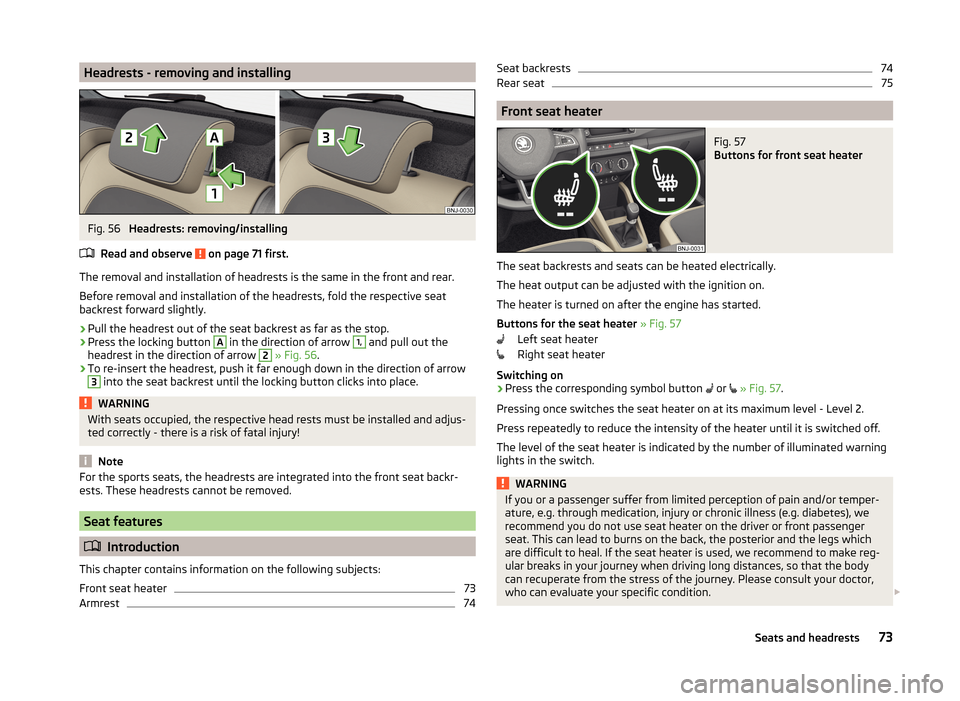
Headrests - removing and installingFig. 56
Headrests: removing/installing
Read and observe
on page 71 first.
The removal and installation of headrests is the same in the front and rear.
Before removal and installation of the headrests, fold the respective seat
backrest forward slightly.
›
Pull the headrest out of the seat backrest as far as the stop.
›
Press the locking button
A
in the direction of arrow
1,
and pull out the
headrest in the direction of arrow
2
» Fig. 56 .
›
To re-insert the headrest, push it far enough down in the direction of arrow
3
into the seat backrest until the locking button clicks into place.
WARNINGWith seats occupied, the respective head rests must be installed and adjus-
ted correctly - there is a risk of fatal injury!
Note
For the sports seats, the headrests are integrated into the front seat backr-
ests. These headrests cannot be removed.
Seat features
Introduction
This chapter contains information on the following subjects:
Front seat heater
73
Armrest
74Seat backrests74Rear seat75
Front seat heater
Fig. 57
Buttons for front seat heater
The seat backrests and seats can be heated electrically.
The heat output can be adjusted with the ignition on.
The heater is turned on after the engine has started.
Buttons for the seat heater » Fig. 57
Left seat heater
Right seat heater
Switching on
›
Press the corresponding symbol button or
» Fig. 57 .
Pressing once switches the seat heater on at its maximum level - Level 2.
Press repeatedly to reduce the intensity of the heater until it is switched off.
The level of the seat heater is indicated by the number of illuminated warning
lights in the switch.
WARNINGIf you or a passenger suffer from limited perception of pain and/or temper-
ature, e.g. through medication, injury or chronic illness (e.g. diabetes), we
recommend you do not use seat heater on the driver or front passenger
seat. This can lead to burns on the back, the posterior and the legs which
are difficult to heal. If the seat heater is used, we recommend to make reg-
ular breaks in your journey when driving long distances, so that the body
can recuperate from the stress of the journey. Please consult your doctor,
who can evaluate your specific condition. 73Seats and headrests
Page 78 of 216
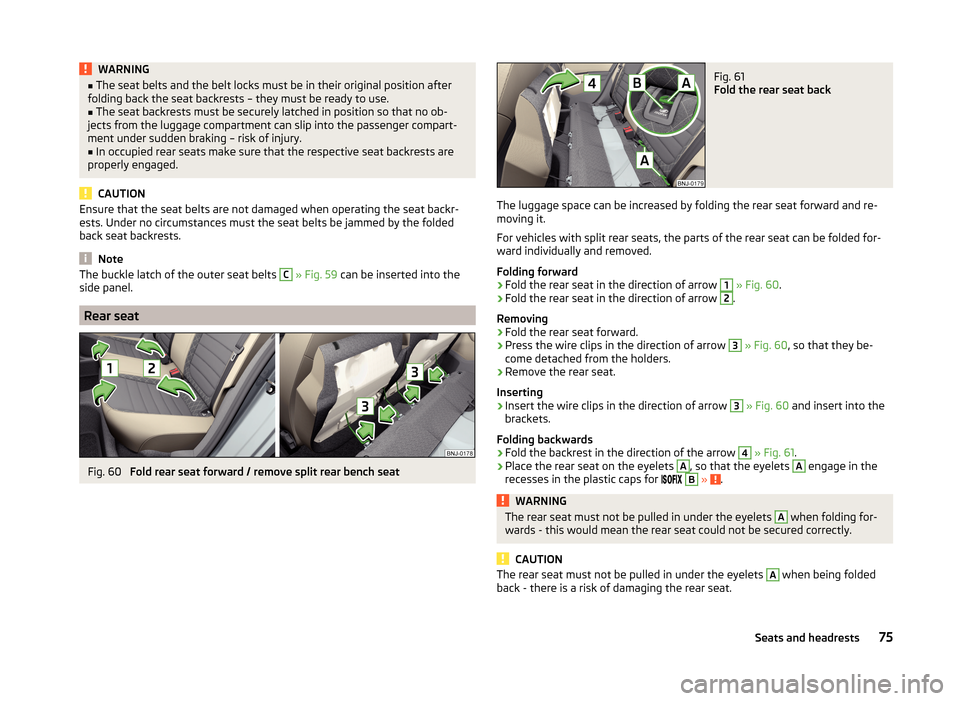
WARNING■The seat belts and the belt locks must be in their original position after
folding back the seat backrests – they must be ready to use.■
The seat backrests must be securely latched in position so that no ob-
jects from the luggage compartment can slip into the passenger compart-
ment under sudden braking – risk of injury.
■
In occupied rear seats make sure that the respective seat backrests are
properly engaged.
CAUTION
Ensure that the seat belts are not damaged when operating the seat backr-
ests. Under no circumstances must the seat belts be jammed by the folded
back seat backrests.
Note
The buckle latch of the outer seat belts C » Fig. 59 can be inserted into the
side panel.
Rear seat
Fig. 60
Fold rear seat forward / remove split rear bench seat
Fig. 61
Fold the rear seat back
The luggage space can be increased by folding the rear seat forward and re-
moving it.
For vehicles with split rear seats, the parts of the rear seat can be folded for-
ward individually and removed.
Folding forward
›
Fold the rear seat in the direction of arrow
1
» Fig. 60 .
›
Fold the rear seat in the direction of arrow
2
.
Removing
›
Fold the rear seat forward.
›
Press the wire clips in the direction of arrow
3
» Fig. 60 , so that they be-
come detached from the holders.
›
Remove the rear seat.
Inserting
›
Insert the wire clips in the direction of arrow
3
» Fig. 60 and insert into the
brackets.
Folding backwards
›
Fold the backrest in the direction of the arrow
4
» Fig. 61 .
›
Place the rear seat on the eyelets
A
, so that the eyelets
A
engage in the
recesses in the plastic caps for
B
» .
WARNINGThe rear seat must not be pulled in under the eyelets A when folding for-
wards - this would mean the rear seat could not be secured correctly.
CAUTION
The rear seat must not be pulled in under the eyelets A when being folded
back - there is a risk of damaging the rear seat.75Seats and headrests
Page 204 of 216
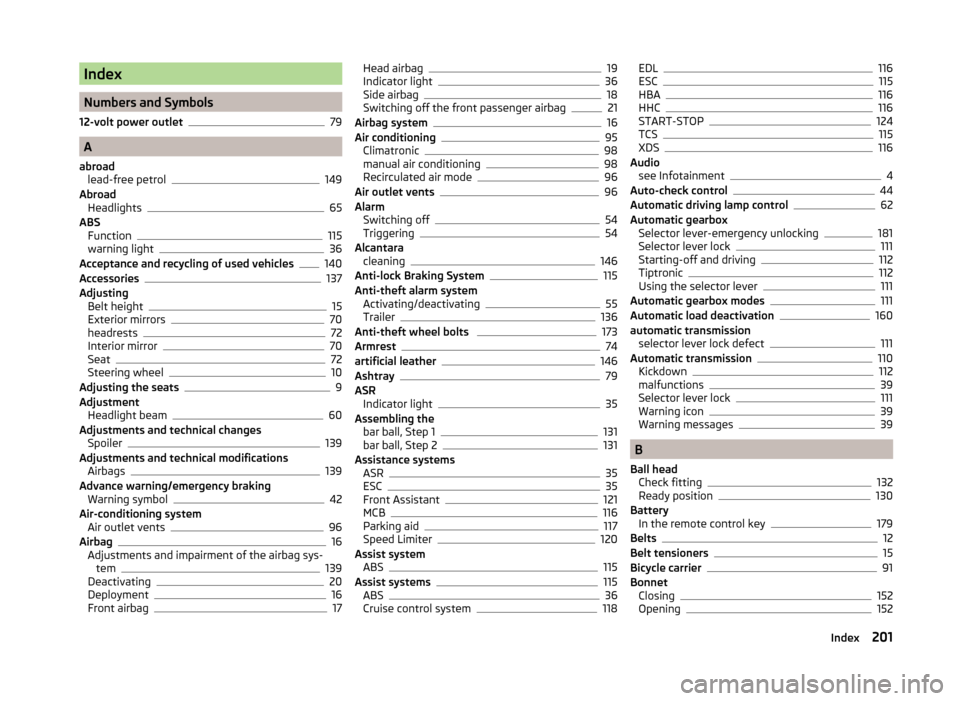
Index
Numbers and Symbols
12-volt power outlet
79
A
abroad lead-free petrol
149
Abroad Headlights
65
ABS Function
115
warning light36
Acceptance and recycling of used vehicles140
Accessories137
Adjusting Belt height
15
Exterior mirrors70
headrests72
Interior mirror70
Seat72
Steering wheel10
Adjusting the seats9
Adjustment Headlight beam
60
Adjustments and technical changes Spoiler
139
Adjustments and technical modifications Airbags
139
Advance warning/emergency braking Warning symbol
42
Air-conditioning system Air outlet vents
96
Airbag16
Adjustments and impairment of the airbag sys- tem
139
Deactivating20
Deployment16
Front airbag17
Head airbag19
Indicator light36
Side airbag18
Switching off the front passenger airbag21
Airbag system16
Air conditioning95
Climatronic98
manual air conditioning98
Recirculated air mode96
Air outlet vents96
Alarm Switching off
54
Triggering54
Alcantara cleaning
146
Anti-lock Braking System115
Anti-theft alarm system Activating/deactivating
55
Trailer136
Anti-theft wheel bolts 173
Armrest74
artificial leather146
Ashtray79
ASR Indicator light
35
Assembling the bar ball, Step 1
131
bar ball, Step 2131
Assistance systems ASR
35
ESC35
Front Assistant121
MCB116
Parking aid117
Speed Limiter120
Assist system ABS
115
Assist systems115
ABS36
Cruise control system118
EDL116
ESC115
HBA116
HHC116
START-STOP124
TCS115
XDS116
Audio see Infotainment
4
Auto-check control44
Automatic driving lamp control62
Automatic gearbox Selector lever-emergency unlocking
181
Selector lever lock111
Starting-off and driving112
Tiptronic112
Using the selector lever111
Automatic gearbox modes111
Automatic load deactivation160
automatic transmission selector lever lock defect
111
Automatic transmission110
Kickdown112
malfunctions39
Selector lever lock111
Warning icon39
Warning messages39
B
Ball head Check fitting
132
Ready position130
Battery In the remote control key
179
Belts12
Belt tensioners15
Bicycle carrier91
Bonnet Closing
152
Opening152
201Index
Page 208 of 216
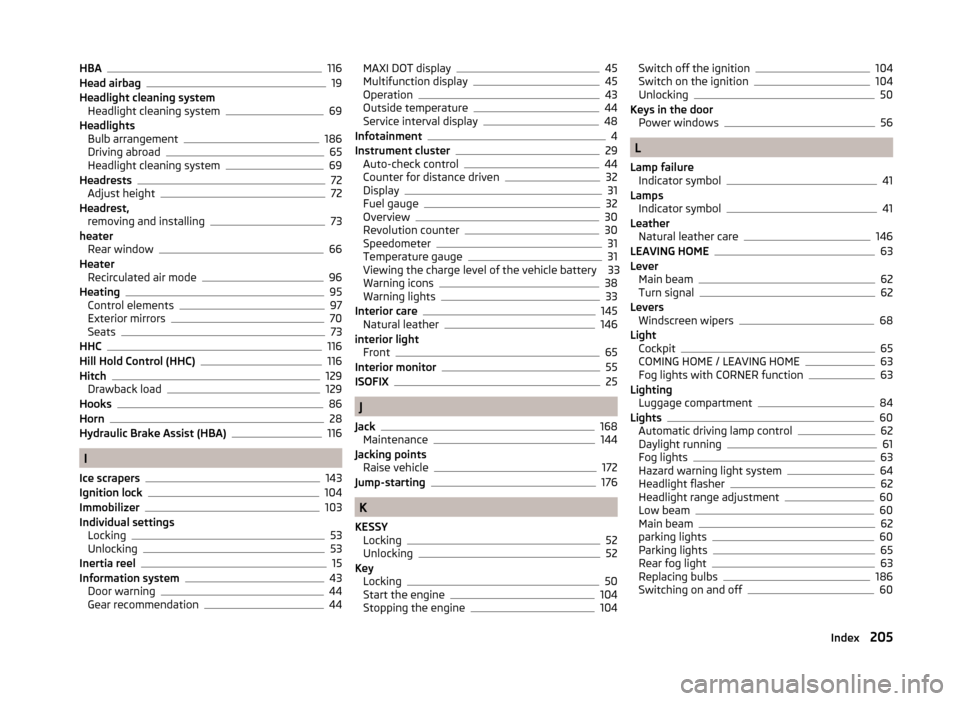
HBA116
Head airbag19
Headlight cleaning system Headlight cleaning system
69
Headlights Bulb arrangement
186
Driving abroad65
Headlight cleaning system69
Headrests72
Adjust height72
Headrest, removing and installing
73
heater Rear window
66
Heater Recirculated air mode
96
Heating95
Control elements97
Exterior mirrors70
Seats73
HHC116
Hill Hold Control (HHC)116
Hitch129
Drawback load129
Hooks86
Horn28
Hydraulic Brake Assist (HBA)116
I
Ice scrapers
143
Ignition lock104
Immobilizer103
Individual settings Locking
53
Unlocking53
Inertia reel15
Information system43
Door warning44
Gear recommendation44
MAXI DOT display45
Multifunction display45
Operation43
Outside temperature44
Service interval display48
Infotainment4
Instrument cluster29
Auto-check control44
Counter for distance driven32
Display31
Fuel gauge32
Overview30
Revolution counter30
Speedometer31
Temperature gauge31
Viewing the charge level of the vehicle battery 33
Warning icons
38
Warning lights33
Interior care145
Natural leather146
interior light Front
65
Interior monitor55
ISOFIX25
J
Jack
168
Maintenance144
Jacking points Raise vehicle
172
Jump-starting176
K
KESSY Locking
52
Unlocking52
Key Locking
50
Start the engine104
Stopping the engine104
Switch off the ignition104
Switch on the ignition104
Unlocking50
Keys in the door Power windows
56
L
Lamp failure Indicator symbol
41
Lamps Indicator symbol
41
Leather Natural leather care
146
LEAVING HOME63
Lever Main beam
62
Turn signal62
Levers Windscreen wipers
68
Light Cockpit
65
COMING HOME / LEAVING HOME63
Fog lights with CORNER function63
Lighting Luggage compartment
84
Lights60
Automatic driving lamp control62
Daylight running61
Fog lights63
Hazard warning light system64
Headlight flasher62
Headlight range adjustment60
Low beam60
Main beam62
parking lights60
Parking lights65
Rear fog light63
Replacing bulbs186
Switching on and off60
205Index
Page 210 of 216
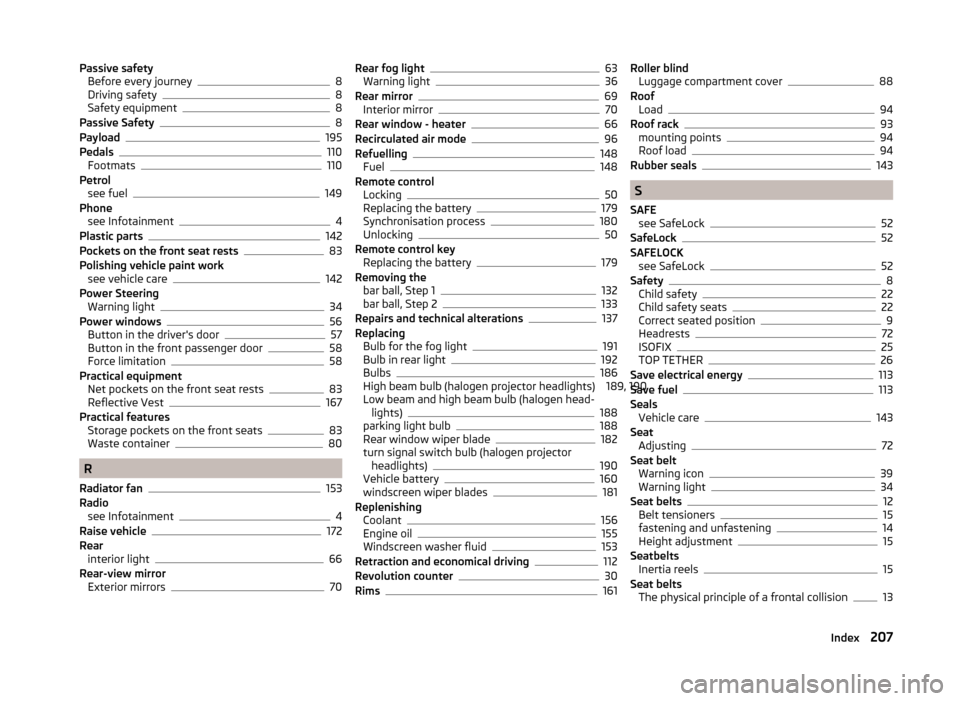
Passive safetyBefore every journey8
Driving safety8
Safety equipment8
Passive Safety8
Payload195
Pedals110
Footmats110
Petrol see fuel
149
Phone see Infotainment
4
Plastic parts142
Pockets on the front seat rests83
Polishing vehicle paint work see vehicle care
142
Power Steering Warning light
34
Power windows56
Button in the driver's door57
Button in the front passenger door58
Force limitation58
Practical equipment Net pockets on the front seat rests
83
Reflective Vest167
Practical features Storage pockets on the front seats
83
Waste container80
R
Radiator fan
153
Radio see Infotainment
4
Raise vehicle172
Rear interior light
66
Rear-view mirror Exterior mirrors
70
Rear fog light63
Warning light36
Rear mirror69
Interior mirror70
Rear window - heater66
Recirculated air mode96
Refuelling148
Fuel148
Remote control Locking
50
Replacing the battery179
Synchronisation process180
Unlocking50
Remote control key Replacing the battery
179
Removing the bar ball, Step 1
132
bar ball, Step 2133
Repairs and technical alterations137
Replacing Bulb for the fog light
191
Bulb in rear light192
Bulbs186
High beam bulb (halogen projector headlights) 189, 190
Low beam and high beam bulb (halogen head- lights)
188
parking light bulb188
Rear window wiper blade182
turn signal switch bulb (halogen projector headlights)
190
Vehicle battery160
windscreen wiper blades181
Replenishing Coolant
156
Engine oil155
Windscreen washer fluid153
Retraction and economical driving112
Revolution counter30
Rims161
Roller blind Luggage compartment cover88
Roof Load
94
Roof rack93
mounting points94
Roof load94
Rubber seals143
S
SAFE see SafeLock
52
SafeLock52
SAFELOCK see SafeLock
52
Safety8
Child safety22
Child safety seats22
Correct seated position9
Headrests72
ISOFIX25
TOP TETHER26
Save electrical energy113
Save fuel113
Seals Vehicle care
143
Seat Adjusting
72
Seat belt Warning icon
39
Warning light34
Seat belts12
Belt tensioners15
fastening and unfastening14
Height adjustment15
Seatbelts Inertia reels
15
Seat belts The physical principle of a frontal collision
13
207Index